Education reform leaders like Bill Gates have disrupted our public schools without considering how their plans disturb the education of children and upset the lives of families. Repeatedly, political and philanthropic leaders force change on our schools without any meaningful open exchange of ideas with parents and educators.
They are in control of education policy. Education policy controls how our public dollars are spent. How our money is spent does matter. Policy — coming down from above — matters. The education reform oligarchs driving their agenda into our laws are the ones ultimately governing our schools.
So it behooves us to look closer at Mr. Bill Gates’ perspective.
Bill Gates’ Views On Public Education Compared To My Perspective — As Just A Parent
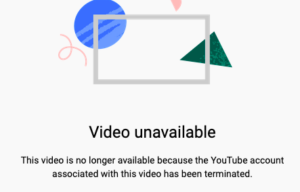
The video was removed. A similar statement was made in another interview. ““The bulk of the money by far will always come from government.”
Mr. Gates…
From what Mr. Gates said, he sees the philanthropic role as being “to shake things up” and fund pilot programs. He says he sees philanthropy as having a “super-narrow role” because the reality is that the public is footing most of the costs.
But what Gates sees as a primary role for philanthropists I saw, beginning in the mid to late 90’s, as a primary problem.
No one had clarified the concept of what exactly a “pilot program” meant.
In this case, the use of the word “pilot” means that children serve as a “trial unit for experimentation.” … The big question becomes: how many were set up for future failures because of pilots gone wrong? From Education’s Missing Ingredient: What Parents Can Tell Educators
The people piloting failed programs didn’t send in cleanup crews. There were no “Super Fund Site” signs going up at my neighborhood schools. But if a person thinks that little learning is actually going on in schools before they step in, they might consider any harm done as insignificant. That may be the case with Mr. Gates.
“K to 12 is partly about babysitting the kids so the parents can do other things.” Source: The Hill, 2010
Wow! Really!?! And I thought that educated mothers around the world wanted their children to get a good education. I believe that is the major reason parents send children to school.
Parents want their children to enter classrooms where the teachers are happy about doing their job and they are enabled to do it well. … Parents want to have a say in how and what their child is taught. From The Crucial Voice of the People: Education’s Missing Ingredient, 2nd edition
So how do we view the school improvement problem?
Bill Gates believes “The key problem is political will.”
What I believe can’t be so simply stated. I believe in “the political principle” as an ideal that politics has failed at miserably.
The political principle is the belief that when decisions are made affecting you or your possessions, you should have a role, a voice in the process of that decision-making. …
And time and again, politics has proven itself to be an irresponsible driver of educational progress.
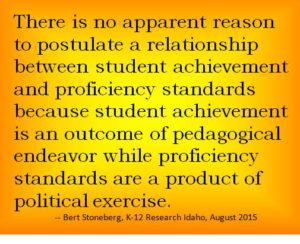
That quote is based on statistical analysis of the rigor of standards and their lack of correlation to student achievement.
And while standards-driven, outcome-based education reform was not Bill Gates’ brainchild, he has become the political and financial driver of the movement. He believes “that stronger standards will help more students live up to their potential.”
For decades, the faith in setting standards as a reform is what politicians and much of the nation agreed to spend education reform dollars on — “ever – higher” standards and the tests to determine achievement outcomes. On this topic, I believe in the historical evidence uncovered through my own research and the facts provided by people a whole lot smarter than I.

Source: The National Academies
But ignoring all that, federal and state policies cemented the idea that standards are the necessary first step in education reform without considering the historical and statistical evidence demonstrating that the standards/outcome-based theory is incorrect.
So when did Bill Gates jump into the education reform arena? Exactly? Well, that’s hard to pin down but what is important to know is that by 2006, Mr. Gates had become the most influential person in education reform policy in America.
What probably matters more is who influenced the influencer?
Here’s a brief look at a few major players…
- 1986 National Governors Association (NGA) meeting, Chaired by then Governor Lamar Alexander, Marc Tucker (from Carnegie Forum on Education and the Economy) made his case for “the necessary revolution in school policy” (p82)
- 1989 Marc Tucker (National Center on Education and the Economy – NCEE) reached out to President H. W. Bush promoting the restructuring of schools, setting of national goals, and focusing on workforce training “To Secure Our Future: The Federal Role in Education.”
- 1990 Tucker’s NCEE publication “America’s Choice” continued the push for benchmarked standards in order for the U.S.A. to remain competitive in the global economy. Marc Tucker clearly urged leaders to focus on output measures at the Task Force on Education Workshop chaired by then Governor Bill Clinton (Tucker minute 33:30).
- 1992 Marc Tucker penned his infamous “Dear Hillary Letter” that became part of Congressional Record (p353) submitted by Representative Bob Schaffer in 1998. (Here is an easier to read copy.)
With political figures — including Bill and Hillary Clinton — on board with the Outcome-Based Education Reform Movement and then Secretary of Education Lamar Alexander cheering the first federal funding earmarked for World Class Standards/Academic Achievement Tests (p93), the federal role in education expanded.
- 1996 The Education Summit brought together governors and business with education and community leaders. Their mission: To start a national effort to establish high academic standards, assessments, accountability and improve the use of school technology as a tool to reach high standards. As the story goes, this meeting gave birth to Achieve, Inc.
- 1997 Lamar Alexander & Bill Gates address the NGA Lamar Alexander mused about how it could be that, after all the years of trying, with the governors “leading the charge” and pouring money into “their plan,” charters and standards had not improved education. Alexander’s answer: “We have been too timid.”
- Bill Gates talked about “digital nervous systems” able to improve the quality and efficiency of public services and provide citizens with access to more knowledge in the “Information Age.”
Bill Gates Steps In — Officially
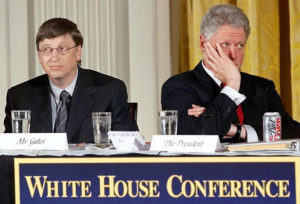 1999 Gates co-founds the Bill and Melinda Gates Foundation. Among many other things, they provided funding for Achieve, Inc.
1999 Gates co-founds the Bill and Melinda Gates Foundation. Among many other things, they provided funding for Achieve, Inc.
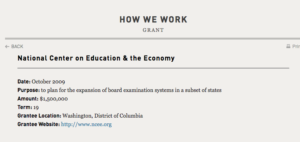 The Gates Foundation became a continuing financial supporter of Marc Tucker’s projects at NCEE.
The Gates Foundation became a continuing financial supporter of Marc Tucker’s projects at NCEE.
2001 — President George W. Bush signed No Child Left Behind into law.
2005 Bill Gates co-chaired the National Education Summit on High Schools. Gates emphasized — there is crisis— our schools are obsolete—and a new design is required.
Influence & The Gates Foundation Agenda
One author put it this way…
The Gates agenda is an intellectual cousin of the Bush Administration’s 2002 No Child Left Behind law.
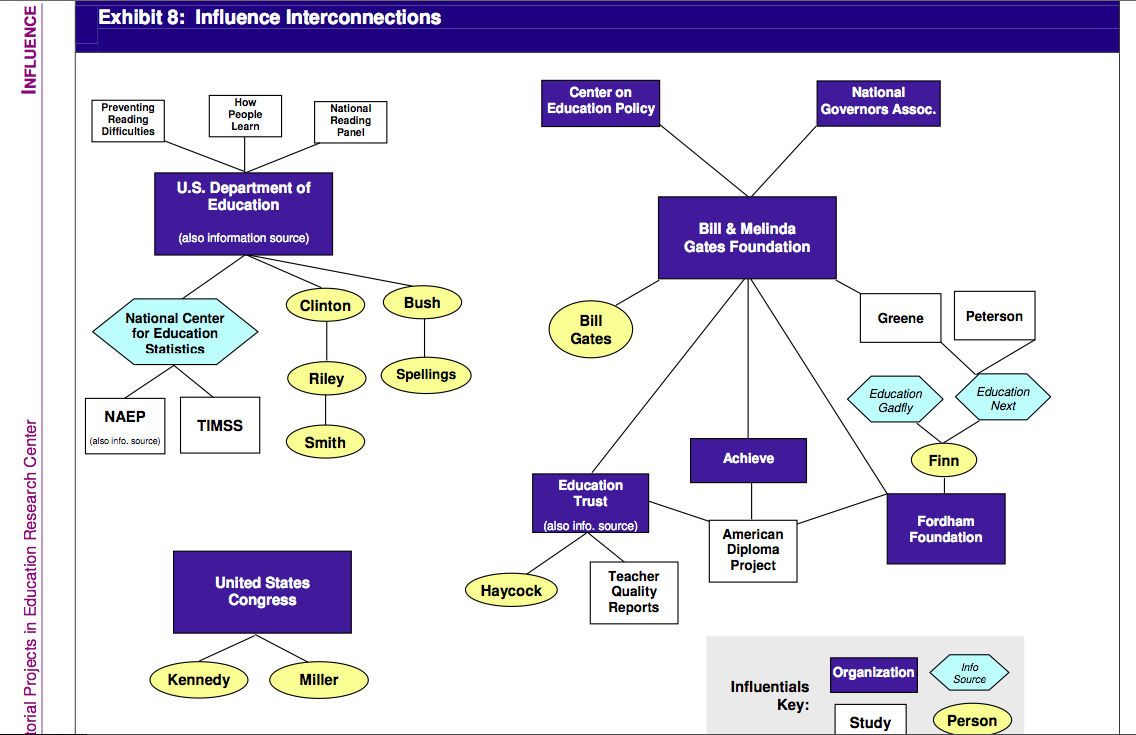
In 2006, with Bill Gates viewed as more influential in education policy that President Bush, the only two government institutions on equal footing with the Gates Foundation were the U.S. Department of Education and Congress…..NOW?
Some players have changed. Who governs is the question.
For Gates to amplify his philanthropic influence, all he needed to do was gain control of Congress and the U.S. Department of Education. … With Marc Tucker as one collaborator, education leaders were trained and placed in the U.S. and many State Departments of Education.
Influencing Congress? It only requires the multiplication of think tanks, organizations and their lobbying efforts.
Now, if you look back at the video clip at the top of this blog (minute 3:18), Mr. Gates chuckles about philanthropy being “so big we could take” over.
- 2006 The Data Quality Campaign Launched at the Data Summit — supported by the Bill & Melinda Gates Foundation. The campaign promoted their “ten essential elements” of a longitudinal data system, which included the ability to match student records between the Pre-K and post-secondary systems.
- 2009 Bill Gates explained at the National Conference of State Legislatures that a thorough data collection system is the best way to track student success. And people, like Parkway, Ohio school board member, Ryan Thompson believe…
“It would be very hard to identify a particular student.”
You be the judge. The following screen shots come directly from documents about data collection and sharing pilot programs put in place simultaneously with Common Core Standards. 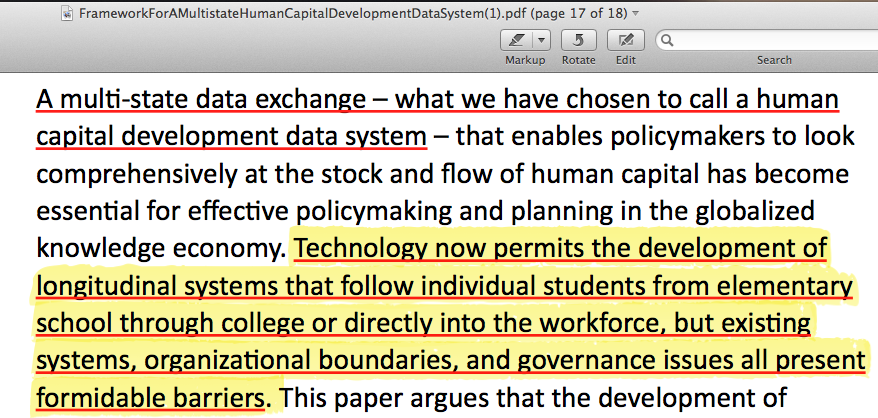

SOURCE Department of Labor: It clearly states (middle of 2nd paragraph), “Ultimately, databases developed through WDQI should be linked to education data at the individual level.”
The years between 2009 and 2014, the Common Core years, created murky waters in the swamp.
Exactly when and how the Workforce Data Quality Initiative (WDQI) arose is probably a story for another time. What is important to know is that real concerns exist for all citizens, particularly for parents wanting to protect their children’s data.
Is the Department of Education addressing parent concerns? How about Congress?
The bill before Congress known as the “Foundations for Evidence-Based Policymaking” (FEPA, H.R.4174) was pushed through the House without debate. The foundation it puts in place is a mega federal database without mention of education data — but that is the plan. Next up will be the College Transparency Act (CTA) which overturns the ban on a federal student record system.
This is the Gates agenda. But go back and read the Dear Hillary Letter. This is the Marc Tucker plan. Is this America’s choice?
“It is not unfair to say that the Gates Foundation’s agenda has become the country’s agenda in education.” Michael Petrilli
To date, leaders have brushed citizen concerns aside and done what they want. That leaves me wondering; is it too late to regain control of schools through civil disobedience? Will that work against an oligarchy?
One thing is certain; our representatives are driving policy while under the influence.


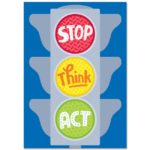
Education is not a Federal issue, although policies can be put in place that impact schools nationwide. (10% of school funds come from the Feds and states can opt out as Utah did). Your comments are skewed by a misunderstanding of what a standard is, what a well controlled and observed “pilot” program is, and the concept of outcomes based assessment of educational practice and how schools are controlled in localities.
A “standard” as envisioned by Achieve and original supporters of Common Core is a guide, a supporting framework and is voluntary. You use standards every day – every appliance you use, regulations of environmental practice, the green and white signs on every freeway in the United States, etc. Used on a voluntary basis for english and math, the focus of Common Core, teachers have a framework within which to collaborate with common language and practice to incrementally improve the learning opportunities for individual children. Unfortunately local school districts and state legislatures viewed Common Core as a mandate, an absolute requirement, applied all their policy and practice and destroyed any opportunity for teachers or groups of teachers to collaborate on improvements to curriculum and pedagogy.
A standard: khanacademy.org, available free to anyone that wants to learn, structured for access by all. A standard – real Montessori programs (not the “Montessori -Like” programs). The Interstate Highway Signs do not tell where to start or end, how to get there or how much time you have, they guide your journey; Kahn does not tell you what to study, how to study, when to study, who to ask for help or where to study, it facilitates the individuals chosen learning journey . The emphasis is on the individual learning journey, not an academic dictate from some anonymous authority at the District level, state education agency or a legislature.
Opponents of change use the words “pilot” or “experiment” in a pejorative manner ignoring the reality that every classroom is an experiment or pilot program that changes every semester or school year. (Take away the contents of the classroom file cabinet at the beginning of the year and watch what happens) The audience for the product called education changes and is changing more rapidly every day. Our 130 year old structure of education (see Ken Robinson’s videos “Are Schools Killing Creativity” and “Paradigms”, a forty minute commitment) cannot keep up, and the students know it.
Outcomes based. Put another way, assessment based upon an actual performance of Mastery of subject matter to peers, teachers, parents and community. I’m certain you do not want a surgeon who graduated with a B average performing a lack of mastery during your heart surgery.
Standardized testing, for a full exposure please see fairtest.org. The masters of understanding and using data to inform the present and the future are Shewhart, Chambers and Deming (for a lesson see “Understanding Variation” by Donald Wheeler, SPC Press) . Their fundamental rule of data, such as test scores, is – data absent context is meaningless. Test scores are meaningless yet our education hierarchy spends tens of millions of taxpayer dollars subjecting our children to the tyranny of the test, ranking and rating, sorting into winners and losers. (because they “desperately need that 10% budget bump)
Solutions must begin in state legislatures – politicians and bureaucrats listening to the classroom. Education’s operational budgets must be developed in the classroom by the teacher focused on meeting the learning needs of each individual student. School building administrations, District and state administrative agencies play a supporting and auditing role – not dictating the appropriation of funds or using budgets as a political or punitive tool. Budgeting for facilities (capital expenses) are a state responsibility with a purpose of ensuring all classrooms are supported by safe, clean and up to date facilities (in Michigan the facilities standard – that awful word – should be the lawfully designated 55 hold harmless districts -its not)
Curriculum and pedagogy must be tailored to the individual child beginning at birth and adjusted throughout their learning journey. Children are born knowing how to learn – watch an infant in action! Use their interests, cognitive attributes and life context to develop a journey they will follow willingly. Let their imagination, curiosity, innovation and intrinsic motivation drive their learning, not the Wizards hiding behind the curtain or the flying monkeys.
Allow teacher to collaborate by facilitating such activities (AKA Funding). Pay teachers well and respect their insights. Put practicing teachers into authoritative roles (AKA empowerment) and always remember this rule when engaging teachers, their students and parent – you have two ears and one mouth, you cannot learn (understand) by talking.
I appreciate your comments, Chuck, but want to clarify a few things you stated in your opening paragraph.
———To me: Your comments are skewed by a a) misunderstanding of what a standard is, b) what a well controlled and observed “pilot” program is, and c) the concept of outcomes based assessment of educational practice and how schools are controlled in localities.
“Opponents of change use the words ‘pilot’ or ‘experiment.’”——-
When I read through your comments and see how much we agree on solutions, I’m not exactly sure why you seem to think I misunderstand so much.
a) Absolutely! My perspective is (skewed as you say) due to experience in exactly the type of schools that the nation — and Mr. Gates’ Achieve and others — say they want to help. My understanding of standards comes from research and, yes, practices as a doctor of veterinary medicine who keeps up with and follows a standard of professional practice.
(I have a file full of research but put this up https://thecrucialvoice.com/for-you-to-use/standards-their-use/ to try and clear up some misunderstandings. SECTION at the top: For YOU To Use)
b) A well-controlled and observed pilot program? Nope. That is not what I saw going on in my schools for the 11 years straight that I was there one to two days weekly, at least. And when you unleash changes without the proper inputs in place first, it is not “controlled.”
Opponents of change? If you are referring to me, I suggest you do check my book out at the library. I am far from an opponent of change…..but I guess most accurately, I’m a proponent for continuous school improvement.
Your surgeon comparison is really not a very good one if the “B” grade you mentioned is based on standardized test scores. I can tell you that practice and skill come very much into play during surgery. There are anatomical structures but they don’t all appear like in the books. There are best practices for surgical procedures but a good surgeon is always prepared for the unexpected…..Grades in medical classes didn’t always correlate to clinical competency…in my experiences in Vet school.
We are in agreement on testing so I’m not sure what I have written that indicates anything different than what you wrote — “Test scores are meaningless yet our education hierarchy spends tens of millions of taxpayer dollars subjecting our children to the tyranny of the test, ranking and rating, sorting into winners and losers.” Agreed….except I do still appreciate the value of an occasional snap shot.
c) The outcome-based assessments in my state, in my schools were standardized. And they still are in their ESSA accountability plan. I wish I had state official that listened.
You have some great suggestions here. I hope people listen to you. Thanks!
In regard to the Common Core State Standards, I think the concept may have some validity but for the fact that no early childhood nor special education specialists were involved in the process. These standards are not developmentally appropriate for many children in kindergarten through the third grade. Forcing teachers to teach developmentally inappropriate material is counterproductive, a waste of time and can/has done harm to student, teacher, parent and the community. Please take a look at the following. Also, look at the film “Building the Machine” to further support my belief that the public school system is being taken apart by people that put profits and ideology over kids.
https://www.christianpost.com/news/bill-gates-monopoly-on-education-standards-to-cost-states-16-billion-90014/
Actually – if you can speak, you can learn.
Chas,
Standards shmandards, especially the CCSS. How did this country become the top dog nation in the world before this whole standards craze?
I patiently await your response. Thanks.
Duane
You hit it out of the park one more time, Vickie!! I view Gates as either being ignorant in regard to what constitutes sound public ed. policy or as a predatory philanthropist willing to disrupt a system that has, over-all, served our country well, for personal reasons. I still think people power will win in the long run. Keep on Pushing!
Thank you. You give me an idea. We should ask him directly. We have nothing to lose.
😉
The false usage of the terms standards and measurement in education discourse lies at the heart of the problems with the supposed “reforms” that have been foisted upon this country in this century. I discuss the problems of using the standards and measurement discourse/meme in Ch. 6 of my book “Infidelity to Truth: Education Malpractices in American Public Education” (available on Amazon or through me).
Chapter 6
Of Standards and Measurement
Truth is not only violated by falsehood; it may be equally outraged by silence. Henri Frederic Amiel
How can anyone be against having standards in the classroom, standards for behavior or learning? Kind of hard to argue against, eh! What is so wrong with holding students accountable to educational standards? Nothing! Except when the term standard is inappropriately and incorrectly used to mean one thing while purporting to signify another.
Surely we need to and must measure student achievement. How are we going to know how the student stands up to the standard? How are we to know how the students in one class, district or state do in comparison to other classes, districts or states if we don’t measure student achievement?
The silence is deafening in regard to the lack of logical thought and the abuse of the language that permeates educational discourse in the standards and measurement movement. The standards and measurement meme in public education has been a part of policies and practices for at least the last quarter of a century. Even before NCLB, state departments of education were making and disseminating “standards” as guides for classroom curriculum. And the emphasis was being guides and not some supposed “standard” against which educational outcomes could be supposedly “measured” for not only the student but teacher, school and district. It wasn’t until the passage of NCLB in 2001 that the standards and measurement meme come to completely dominate not only school life but the policy and practice arenas from the legislatures to state departments of educations to district boards and into the schools.
The standards and measurement movement is choking the life out of our public school classrooms!
It is causing innumerable harms to students, distorting curriculum and the teaching and learning process, many times into a year-long test prep program, causing districts to drop many electives, foreign languages, band, choir, and many others not related to the two main tested subjects English and Math. Not only that but in the elementary level many students are now deprived of much needed recess/play time, gone are learning stations in favor of drill and kill methods of attempting to raise test scores. Ever increasing test scores have become the predominant driver of curriculum since NCLB was signed into law .
In order to untangle this mess of educational malpractices that standards and measurement discourse has brought about we first need to examine exactly what are standards and measurements in a broader logical context which will enable us to ascertain just how damaging the misuse of language, the twisted use of logic that makes the standards and measurement movement appear to be THE way to improve the teaching and learning processes in American public schools. It will then be shown that using the false and error filled practices of educational standards and standardized testing contravene the fundamental purpose of public education causing, at times, irrevocable harm to the student in not guaranteeing “to promote the welfare of the individual so that each person may savor the right to life, liberty, the pursuit of happiness, and the fruits of their own industry.”
The word standard is in the top 1000 most used words in American English and the Miriam Webster online dictionary gives the following definitions :
Standard
1: a conspicuous object (as in a banner) formerly carried at the top of a pole and used to mark a rallying point especially in battle or to serve as an emblem
2a: a long narrow tapering flag that is personal to an individual or corporation and bears heraldic devices b: the personal flag of the head of state or of a member of a royal family c: an organization flag carried by a mounted or motorized military unit d: banner
3: something established by authority, custom, or general consent as a model or example: criterion
4: something set up and established by authority as a rule for the measure of a quantity, weight, extent, value, or quality
5a: the fineness and legally fixed weight of the metal used in coins b: the basis of value in a monetary system
6: a structure built for or serving as a base of support
7a: a shrub or herb grown with an erect main stem so that it forms or resembles a tree b: a fruit tree grafted on the stock that does not induce dwarfing
8a: the large odd upper petal of a papilionaceous flower (as of the pea) b. one of the three inner usually erect and incurved petals of an iris
9: a musical composition (as a song) that has become a part of the standard repertoire
For the purposes of this discussion, obviously definitions 1, 2, 5, 6, 7, 8, and 9 do not concern us. It is the somewhat similar and perhaps inter-confusing definitions of 3 and 4 that interest us.
As mentioned above before NCLB the definition of standard as used in the individual state’s curriculum standards and even today in curriculum standards promulgated and promoted by subject area organizations such as the National Council of Teachers of Mathematics or the American Council of Teachers of Foreign Languages the term standard as used fell/falls under definition three as they were never meant to be used as “a rule for the measure of a quantity, weight, extent, value, or quality” as in definition four but as a model for teachers to use. Confusing indeed!
Another way to look at the concept of standards is that there are two accepted types of standards, metrological and documentary.
Metrology is the science of measurement and a metrological standard “is an object, system, or experiment that bears a defined relationship to a unit of measurement of a physical quantity. Standards are the fundamental reference for a system of weights and measures, against which all other measuring devices are compared. Measurements are defined in relationship to internationally-standardized reference objects, which are used under carefully controlled laboratory conditions to define the units of length, mass, electrical potential, and other physical quantities.”
A documentary standard “is a document established by consensus and approved by a recognized body, that provides, for common and repeated use, rules, guidelines or characteristics for activities or their results, aimed at the achievement of the optimum degree of order in a given context.”
Many governmental departments promulgate documentary standards, for example the Food and Drug Administration (FDA) or the Environmental Protection Agencies (EPA) while at the same time being the certifying agent to ensure that the standards are followed. The ISO promulgates international standards but is not the certifying agency, other agencies do the certifying of companies compliance with their standards. From the EPA:
“When developing regulations, the first thing we do is ask if a regulation is needed at all. Every regulation is developed under slightly different circumstances but this is the general process:
Step 1: EPA Proposes a Regulation
The agency researches the issues and, if necessary, proposes a regulation, also known as a Notice of Proposed Rulemaking (NPRM). The proposal is listed in the Federal Register (FR) so that members of the public can consider it and send their comments to us. The proposed rule and supporting documents are also filed in EPA’s official docket on Regulations.gov
Step 2: EPA Considers Your Comments and Issues a Final Rule
Generally, once we consider the comments received when the proposed regulation was issued, we revise the regulations accordingly and issue a final rule. This final rule is also published in the FR and in EPA’s official docket on Regulations.gov.
Step 3: The Regulation is Codified in the Code of Federal Regulations
Once a regulation is completed and has been printed in the FR as a final rule, it is codified when it is added to the Code of Federal Regulations (CFR). The CFR is the official record of all regulations created by the federal government. . . . ”
The ISO has strict rules for making and issuing standards. The key principles in standard(s) development:
1. ISO standards respond to a need in the market.
ISO does not decide when to develop a new standard, but responds to a request from industry or other stakeholders such as consumer groups. Typically, an industry sector or group communicates the need for a standard to its national member who then contacts ISO.
2. ISO standards are based on global expert opinion.
ISO standards are developed by groups of experts from all over the world that are part of larger groups called technical committees. These experts negotiate all aspects of the standard, including its scope, key definitions and content.
3. ISO standards are developed through a multi-stakeholder process.
The technical committees are made up of experts from the relevant industry, but also from consumer associations, academia, NGOs and government.
4. ISO standards are based on a consensus
Developing ISO standards is a consensus-based approach and comments from all stakeholders are taken into account.
The Common Core State Standards (CCSS) and all other state educational standards might be considered a documentary standard but in the development of the standards no procedures have followed the formal protocol and processes as outlined by the OSI or government agencies in their development.
In addition to that and perhaps even worse is that the proponents of these standards claim that the CCSS are standards against which ‘student achievement’ can be measured. In doing so educational standards proponents claim the documentary standard (definition three) as a metrological standard (definition four). In doing so they are falsely claiming a meaning of standard that should not be given credence .
This confusion is compounded by what it means to measure something and the similar misuse of the meaning of the word measure by the proponents of the standards and testing regime. Assessment and evaluation perhaps can be used interchangeably but assessment and evaluation are not the same as measurement. Word usage matters!
The Merriam-Webster dictionary definition of measure includes the following:
1a (1): an adequate or due portion (2): a moderate degree; also: moderation, temperance (3): A fixed or suitable limit: bounds b: the dimensions, capacity or amount of something ascertained by measuring c: an estimate of whit is to be expected (as of a person or situation d: (1): a measured quantity (2): amount, degree
2a: an instrument or utensil for measuring b (1): a standard or unit of measurement—see weight table (2): A system of standard units of measure
3: the act or process of measuring
4a (1): melody, tune (2): dance; especially: a slow and stately dance b: rhythmic structure or movement: cadence: as (1): poetic rhythm measured by temporal quantity or accent; specifically: meter (2): musical time c (1): a grouping of a specified number of musical beats located between two consecutive vertical lines on a staff (2): a metrical unit: foot
5: an exact divisor of a number
6: a basis or standard of comparison <wealth is not a measure of happiness
7: a step planned or taken as a means to an end; specifically: a proposed legislative act
Measure as commonly used in educational standard and measurement discourse comes under definitions 1d, 2, and 3, the rest not being pertinent other than to be used as an obfuscating meaning to cover for the fact that, indeed, there is no true measuring against a standard whatsoever in the educational standards and standardized testing regimes and even in the grading of students. What we are left with in this bastardization of the English language is a bewildering befuddle of confusion that can only serve to deceive many into buying into intellectually bankrupt schemes that invalidly sort, rate and rank students resulting in blatant discrimination with some students rewarded and others punished by various means such as denying opportunities to advance, to not being able to take courses or enroll in desired programs of study.
The most misleading concept/term in education is "measuring student achievement" or "measuring student learning". The concept has been misleading educators into deluding themselves that the teaching and learning process can be analyzed/assessed using "scientific" methods which are actually pseudo-scientific at best and at worst a complete bastardization of rationo-logical thinking and language usage.
There never has been and never will be any "measuring" of the teaching and learning process and what each individual student learns in their schooling. There is and always has been assessing, evaluating, judging of what students learn but never a true "measuring" of it.
The TESTS MEASURE NOTHING, quite literally when you realize what is actually happening with them. Richard Phelps, a staunch standardized test proponent (he has written at least two books defending the standardized testing malpractices) in the introduction to “Correcting Fallacies About Educational and Psychological Testing” unwittingly lets the cat out of the bag with this statement:
“Physical tests, such as those conducted by engineers, can be standardized, of course, but in this volume, we focus on the measurement of latent (i.e., nonobservable) mental, and not physical, traits.”
Notice how he is trying to assert by proximity that educational standardized testing and the testing done by engineers are basically the same, in other words a “truly scientific endeavor”. The same by proximity is not a good rhetorical/debating technique.
Since there is no agreement on a standard unit of learning, there is no exemplar of that standard unit and there is no measuring device calibrated against said non-existent standard unit, how is it possible to “measure the nonobservable”?
PURE LOGICAL INSANITY!
Finally, what the proponents of the educational standards and standardized testing regime don't appear to understand is that in many areas of human feelings and interactions there cannot be any measurement. How does one measure the love of one's spouse, children, parents or friends? How does one measure what is going on in the heart and mind of a distressed person who has just lost a loved one? Why do we even begin to think that we can measure what goes on in the body and brain of the student who is learning any subject matter considering all the various hormonal and endocrinal influences occurring outside the individual's control, with the hundreds of millions if not billions of neuronal firings going on at any given moment that partially influence what happens in the mind of the student in a teaching and learning situation? How do we believe that the thousands and thousands of environmental influences on each individual could begin to be measured and accounted for? Are proponents of the educational standards and standardized testing "measurement" regime that arrogant, hubristic and presumptuous to believe that they hold the key to measuring the teaching and learning process or more specifically, the learning, aka, student achievement, of an individual student?
Considering the facts of the misuse of language, logic and common sense as outlined above, the only wise course of action is to immediately cease and desist, to abandon those malpractices that harm so many students and contravene the state's responsibility in providing a public education for all students. The billions of dollars spent by states on the educational standards and standardize testing regime would then be freed up to provide a better education for all students through perhaps such things as smaller class sizes, needed social services, foreign language instruction, arts programs, etc. And the state, by approving and mandating the fake standards and false measuring of student learning that are the malpractices of educational standards and standardized testing, is surely guilty of not promoting "the welfare of the individual so that each person may savor the right to life, liberty, the pursuit of happiness, and the fruits of their own industry."
Pingback: The designing of an educational system to create unchained slaves.
Pingback: A Clear Plan: The Revolution in School Policy | The Crucial Voice of the PeopleThe Crucial Voice of the People